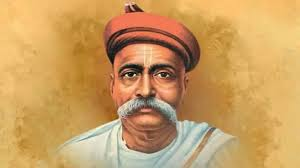Legacy of Lokmanya Tilak | 01 Aug 2020
This article is based on “Lokmanya Tilak: Father of the Indian renaissance” which was published in The Hindustan Times on 1/08/2020. It talks about the Legacy of Lokmanya Tilak.
“Swaraj is my birthright and I shall have it!”, this is the slogan that inculcated a political conscience among Indians regarding self-rule. The slogan was given by Lokmanya Bal Gangadhar Tilak (Lokmanya means the man accepted by the people). Given his contribution, Tilak can be hailed as the first mass leader of the Indian Independence Movement.
Mahatma Gandhi called him ‘The Maker of Modern India’ or as British colonial authorities called him ‘the father of Indian unrest’, testifies his legacy and contribution to Indian society and freedom struggle.
As a philosopher-politician, his contribution is immense as he is said to be a pioneer of ideas of swaraj and swadeshi and used culture, education and the media.
Contribution of Bal Gangadhar Tilak
- Igniting Patriotism: Ruthless suppression of the revolt of 1857 by the British and its aftermath, had created disillusionment and darkness regarding self-rule, that continued for many decades.
- This is when Tilak began to quicken the growth of nationalist consciousness with the advent of the 20th century.
- He ignited patriotic consciousness among the masses during one of the most difficult periods in the freedom struggle
- Switching to Extremism Phase: The founding of the Indian National Congress (INC) in 1885 was aided by the British, under the narrative of safety-value theory.
- As a followup to that, the voice of INC was weak and subdued. Early leadership of INC was mainly focused on 3Ps: Prayer, Petition and Protest.
- Along with two other congress leaders, Lala Lajpat Rai and Bipin Chandra Pal (popularly known as Lal, Bal and Pal), he started the extremist phase of INC, which focused on mass mobilisation of masses.
- Trisutri Program: Tilak gave trisutri or three-point programme for national awakening – Swaraj, Swadeshi and Nationalist Education based on vernacular.
- This helped the realisation of self-pride and activism in a nation that was culturally suppressed by the British under the narrative of Whiteman’s burden.
- For the cultivation of an enlightened mind, he used the media in the form of two newspapers, Kesari and Maratha, and national education through Deccan Education Society, an institute he established.
- Swadeshi Movement: Tilak started the Swadeshi movement (1905), which was not just about boycotting British goods, but his larger objective was promoting indigenous entrepreneurship.
- Tilak wanted to promote manufacturing in India. To that end, Tilak started collecting funds for a corpus, known as Paisa Fund.
- This can be termed as reminiscent of the Make in India Program, in present times.
- Broader Vision of Swaraj: For him, Swaraj or Home Rule meant the rule of, and the rule for, the common people of India. However, he also had a blueprint of an independent India in mind.
- For him, swaraj was also linked to swa-bhasha and swa-bhusha, i.e. mother tongue and indigenous attire.
- Perhaps, he was the first national leader who envisioned the formation of linguistic states.
- Laying Foundation for Gandhian way of Mass Movement: Tilak’s two arrests by the British in (1897 and 1908) galvanised workers, peasants, professionals and youth in an unprecedented manner.
- His formula for preparing the ground for political activism through culture, education and media was so powerful that later on Mahatma Gandhi, Babasaheb Ambedkar and others adopted this path.
- Also, he prepared a fertile ground for swaraj through his home-rule movement.
- Cultural Revival: Tilak’s campaign against the British colonial rule was also anchored on reclaiming Indian heritage and culture.
- In 1896, he famously initiated the ‘sarvajanik Ganesh visarjan utsav’ in Bombay, in which the masses of people came out to worship and then immerse idols of Ganesha in the sea.
- This religious drive served the political purpose of mass mobilisation.
- Though it is seen as a communal move by many historians, his writings reflected that his call for public celebration of these festivals was not meant to rouse sentiments against any other community.
- Its sole purpose was cultural self-assertion of his people then living the yoke of foreign rule.
Conclusion
Today, when we talk about Atmanirbhar Bharat, the legacy of Tilak is carried forward. Reviving the spirit of economic nationalism for indigenously manufactured goods and striving for social integration through culture (Ek Bharat Shreshtha Bharat) are the features of Tilak’s strategy and they continue to be relevant even today as we observe his 100th death anniversary.
|
Drishti Mains Question Discuss the relevance of the ideas of Bal Gangadhar Tilak in the present times. |
This editorial is based on “On education, a positive blueprint” which was published in The Hindustan Times on July 30th, 2020. Now watch this on our Youtube channel.

